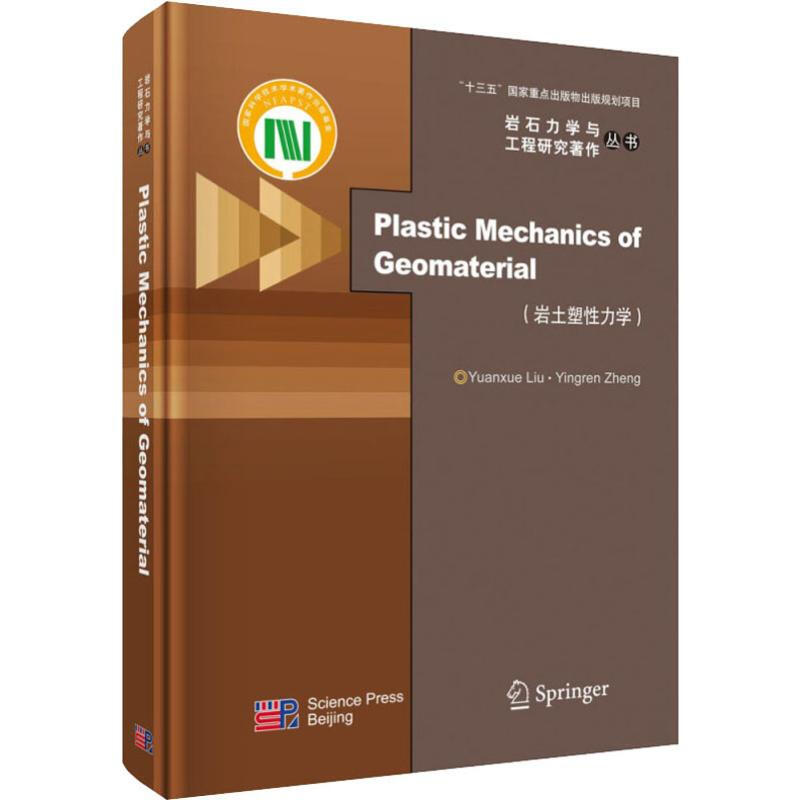
出版社:科學出版社 ISBN:9787030601827 商品編碼:53487331338 品牌:文軒 出版時間:2019-08-01 代碼:180 作者:YuanxueLiu,YingrenZheng
" 作 者:Yuanxue Liu,Yingren Zheng 著  定 價:180  出 版 社:科學出版社  出版日期:2019年08月01日  頁 數:250  裝 幀:精裝  ISBN:9787030601827   ●1 Introduction
1.1 BasicConcept
1.1.1 Plastic Deformation
1.1.2 Plastic Mechanics
1.1.3 Plastic Mechanics of Geomaterial
1.2 The Basic Hypothesis of Plastic Mechanics of Geomaterial
1.3 The Constitutive Model
1.3.1 What Is Model
1.3.2 Model in Classical Soil Mechanics
1.4 Development History for Plastic Mechanics of Geomaterial
References
2 Stress and Strain and Its Basic Equations
2.1 Continuum Model
2.2 Stress Tensor
2.3 Decomposition of Stress Tensor and Its Invariants
2.3.1 Decomposition of Stress Tensor
2.3.2 Other Representation of Stress Invariant
2.4 Deformation and Strain
2.5 The Invariant of Strain Tensor
2.6 Decomposition of Strain Tensor and Its Invariants
2.6.1 Decomposition of Strain Tensor
2.6.2 Other Representation of Strain Invariant
2.7 Stress Path and Strain Path
2.7.1 Expression of Stress Path
2.7.2 The Realization of Stress Path
2.7.3 Total Stress Path and Effective Stress Path
2.7.4 Strain Path
2.8 Basic Equations of Plastic Mechanics of Geomaterial
2.8.1 Basic Equations
2.8.2 Boundary Condition and Initial Value
References
3 The Basic Mechanical Characteristics of the Geomaterial
3.1 Pressure-Hardening
3.2 Yield Caused by Hydrostatic Pressure
3.3 Dilatancy
3.4 Plastic Deformation Dependent on Stress Path
3.5 Other Important Characteristics
3.6 Mechanical Characteristic at Small Strain of Geomaterial
3.7 Mechanical Difference for the Natural and Remoulded Soil
References
4 The Elastic Model of Geomaterial
4.1 Nonlinear Elastic Theory
4.1.1 Variable Elasticity Theory
4.1.2 Hyperelastic Theory
4.1.3 Hypoelastic Theory
4.2 The Anisotropic Elastic Theory
4.2.1 Isotropic Elastic Constitutive Model
4.2.2 The Elastic Constitutive Model with Cross-Anisotropy
4.3 The Isotropic Nonlinear Elastic Model of Geomaterial
4.3.1 The Basic Principle of Duncan-Chang Model
4.3.2 Two Elastic Function of Duncan-Chang Model
4.3.3 Review of Duncan-Chang Model
4.4 The Elastic Model with Transverse Isotropy
4.4.1 ao-nan Gong Model
4.4.2 Graham Model
References
5 Classical Plastic Theory
5.1 Potential Function and Thermodynamics
5.1.1 First Law of Thermodynamics
5.1.2 Second Law of Thermodynamics
5.1.3 Thermodynamics Potential and Dissipative Inequality
5.2 Plastic tulate
5.2.1 Drucker's Stability tulate
5.2.2 Inference of Drucker's tulate
5.3 The Constitutive Model Based on the Classic Plastic Theory
5.3.1 The Framework of the Classic Plastic Theory
5.3.2 Commonly Used Models
References
6 The Development of the Plastic Theory of Geomaterial
6.1 Study of Several Basic Problems in Plastic Theory of Geomaterial
6.1.1 Proving that Drucker tulate Is Unsuitable for Geomaterial
6.1.2 Proving that the Classic Plastic Theory Is Unsuitable for Geomaterial
6.1.3 Study of Several Key Problems in the Plastic Theory of Geomaterial
6.2 Development of the Yield Surface for Geomaterial
6.2.1 Significance of Yield Surface
6.2.2 Yield of Geomaterial
6.2.3 The Shear Yield Surface
6.2.4 Volumetric Yield Criterion
6.2.5 Yield Surface of Overconsolidated Soil
6.2.6 Part Yield
6.3 Hardening Laws
6.3.1 Hardening Theory
6.3.2 Hardening Model
6.3.3 Isotropic Hardening
6.3.4 Kinematic Hardening
6.3.5 Mixed Hardening
6.3.6 The General Form of Hardening Model
6.4 Plastic Flow Rule
6.4.1 Associated Flow Rule
6.4.2 Nonassociated Flow Rule
6.4.3 Mixed Flow Rule
6.5 Loading-Unloading Rule
6.5.1 Loading-Unloading Rule Based on Yield Surface
6.5.2 Loading-Unloading Rule with Stress Type
6.5.3 Loading-Unloading Rule with Strain Style
References
7 The Static Elastoplastic Model for Geomaterial
7.1 Cam-Clay and Modified Cam-Clay Model
7.1.1 The Concept of Critical States
7.1.2 Cam-Clay Model
7.1.3 Modified Cam-Clay Model
7.1.4 Comment on Cam-Clay Model
7.2 Lade Model
7.2.1 Components of Constitutive Model
7.2.2 Elastic Behavior
7.2.3 Failure Criterion
7.2.4 Plastic Potential and Flow Rule
7.2.5 Yield Criterion and Work-Hardening/Softening Relation
7.2.6 Determination of Material Parameters
7.2.7 Model Comments
7.3 A Unified Hardening Constitutive Model for Soils
7.3.1 Introduction
7.3.2 The Unified Hardening Parameter Which Has Nothing to Do with the Stress Path
7.3.3 Unified Hardening Model for Natural Consolidation
7.3.4 The Unified Hardening Model of the Normal
Consolidated Soil
7.3.5 The Stress-Strain Relationship
7.3.6 Model Comments
References
8 Generalized Plastic Mechanics Considering the Rotation of Principal Axis of Stress
8.1 Decomposition of the Stress Increment.
8.1.1 Decomposition of Two-Dimensional Stress Increment.
8.1.2 Decomposition of Three-Dimensional Stress Increment.
8.2 Generalized Plastic Potential Theory Considering Rotation of Principal Stress Axis
8.3 Complete Stress Increment Expression of Elastoplastic Stress-Strain Relationship for Geomaterial
8.4 Plastic Deformation Caused by Coaxial Stress Increment
8.5 Plastic Deformation Caused by the Rotational Increment
8.5.1 Plastic Deformation Caused by Stress Increment
8.5.2 Plastic Deformation Caused by Rotational Stress Increment dCir2 and drir
8.6 Elastoplastic Stress-Strain Relations Considering Rotation of Principal Stress Axis
8.6.1 Elastic Compliance Matrix
8.6.2 Coaxial Plastic Compliance Matrix
8.6.3 Rotating Plastic Compliance Matrix
References
9 The Dynamic Constitutive Model of Geomaterial
9.1 Basic Characteristics of Dynamic Stress -Strain Relationship of Geomaterial
9.2 Empirical Model for Dynamic Stress-Strain Relationship
9.3 Equivalent Dynamic Linear Viscoelastic Model of Soil.
9.3.1 Viscoelastic Model
9.3.2 Parameter for Viscoelastic Model
9.4 Viscoelastoplastic Dynamic Constitutive Model of Geomaterial
9.4.1 Framework for Viscoelastic Plasticity Model
9.4.2 The Computation of Viscoelastic Part
9.4.3 The Computation of Elastoplastic Part
9.4.4 The Computation of Total Part
9.5 Viscoplastic Cap Models
9.5.1 The Perzyna-Type Viscoplastic Cap Model
9.5.2 Solution Algorithms
9.5.3 The Duvant-Lions Type Viscoplastic Cap Model
9.5.4 Illustration Example
References
10 Limit Analysis for Geotechnical Engineering
10.10 verview
10.2 The Basic Equations for Limit Analysis
10.3 The Characteristic Line Method in Limit Analysis
10.3.1 Slip Line of Stress
10.3.2 Prandtl Solution of Stress Characteristic Line for Ultimate Load of a Half-Infinite Plane Body
10.3.3 Velocity Slip Line Field for Plane Strain Problem
10.4 Principle of Limit Analysis and Approximate Method
10.4.1 Limit Analysis Theorem
10.4.2 Example of Limit Analysis Principle
10.5 Numerical Limit Analysis
10.5.1 The Basic Principle of FEM Limit Analysis
10.5.2 Definition of Safety Factor
10.5.3 Criterion for Limit State
10.5.4 Example for the Calculation of Slope Safety Factor
References  本書是作者關於岩土塑性力學長期教學與科研工作成果的凝聚。力圖深入淺出的闡述岩土塑性基本概念、靜動力基本力學特性、非線性與經典塑性理論、岩土屈服面理論、硬化模型、流動法則與加卸載準則、主應力軸旋轉計算理論,以及岩土極限分析及其近期新進展-極法。較為詳細地介紹了代表性的岩土靜動力本構模型。期冀讀者能對岩土基本力學特性與本構模型有深入繫統的認識,可以針對具體工程問題與岩土特性,選用與建立合理本構模型。 
" | 



